1976 CHEVROLET MONTE CARLO air condition
[x] Cancel search: air conditionPage 35 of 102
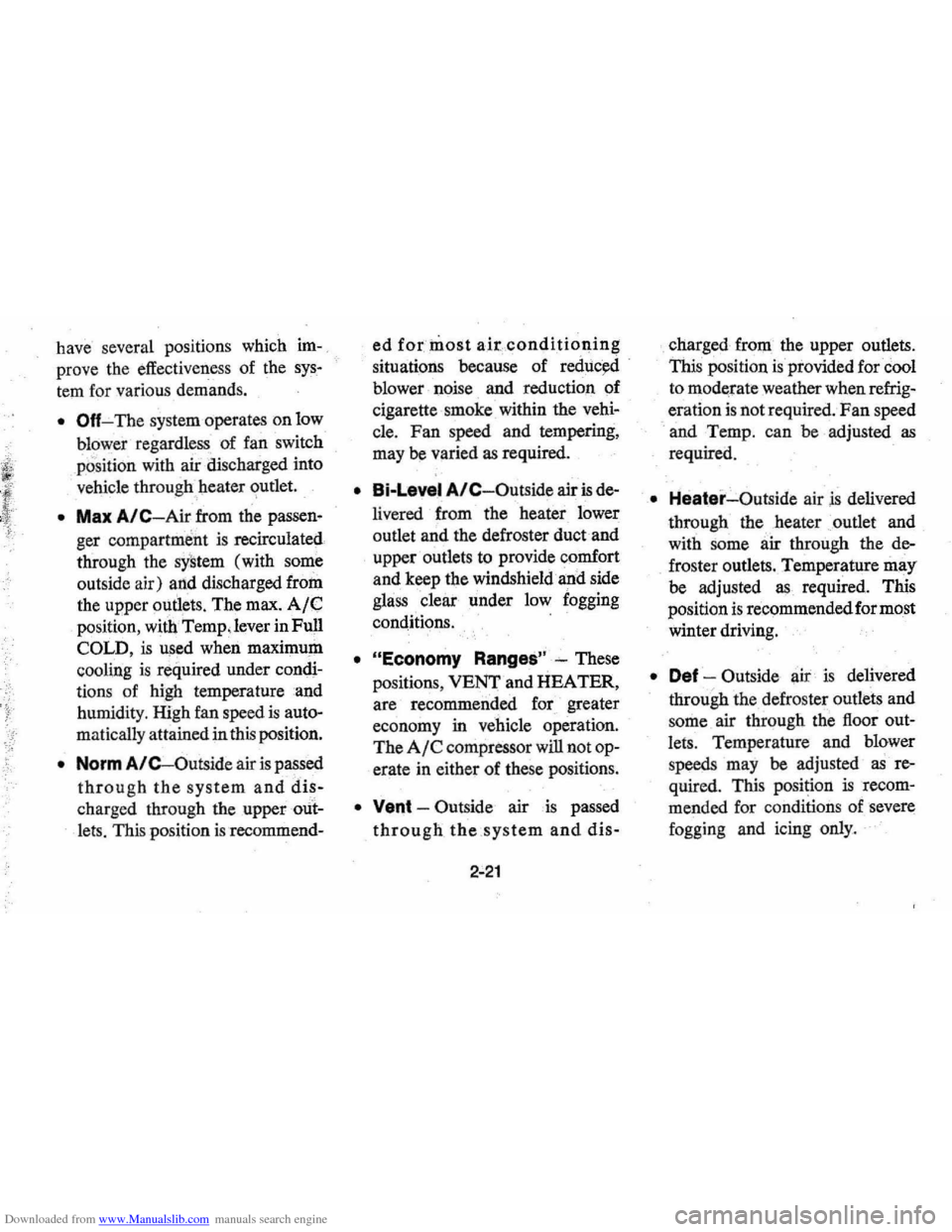
Downloaded from www.Manualslib.com manuals search engine have several positions which im
prove the effectiveness of the sys
tem for various demands.
• Off-The system operates on low
blower regardless of fan switch
position with air discharged into
vehicle
through ,beater outlet.
• Max A/C-Air from the passen
ger compartment is recirculated
through the
system (with some
outside air) and discharged
from
the upper outlets. The max. Ale
position, with Temp, lever in Full
COLD,
is us~d when maximum
cooHng is required under condi
tions of high temperature and
humidity. High fan speed
is auto
matically attained in
this position.
• Norm A/C-Outside air is passed
through the system and dis
charged through the upper out
lets. This position is recommend-
ed for most air,conditioning
situations because of reduclld
blower noise and reduction of
cigarette smoke within the
vehi
cle. Fan speed and tempering,
may
be varied as required.
• Bi-Level A/C-Outside air is de
livered from the heater lower
outlet and the defroster duct and
upper outlets to provide comfort
and keep the windshield and side
glass clear under low fogging
conditions.
• "Economy Ranges" ~ These
positions, VENT
and HEATER,
are recommended
for greater
economy in vehicle operation.
The
AIC compressor will not op
erate in either of these positions.
• Vent -Outside air is passed
through the system and dis-
2-21
charged frorn the upper outlets.
This position
is provided for cool
to rnoderate weather when
refrig
eration is not required. Fan speed
.. and Temp. can be adjusted as
required.
• Heater-Outside air is delivered
through the heater outlet and
with some air through the
de
froster outlets .. Temperature may
be adjusted
as required. This
position
is recommended for most
winter driving.
• Oef -Outside air is delivered
through the defroster outlets and
some air through the floor
out
lets. Temperature and blower
speeds may be adjusted
wire
quired. This position isrecom
mended for conditions of severe
fogging and icing only.
Page 36 of 102
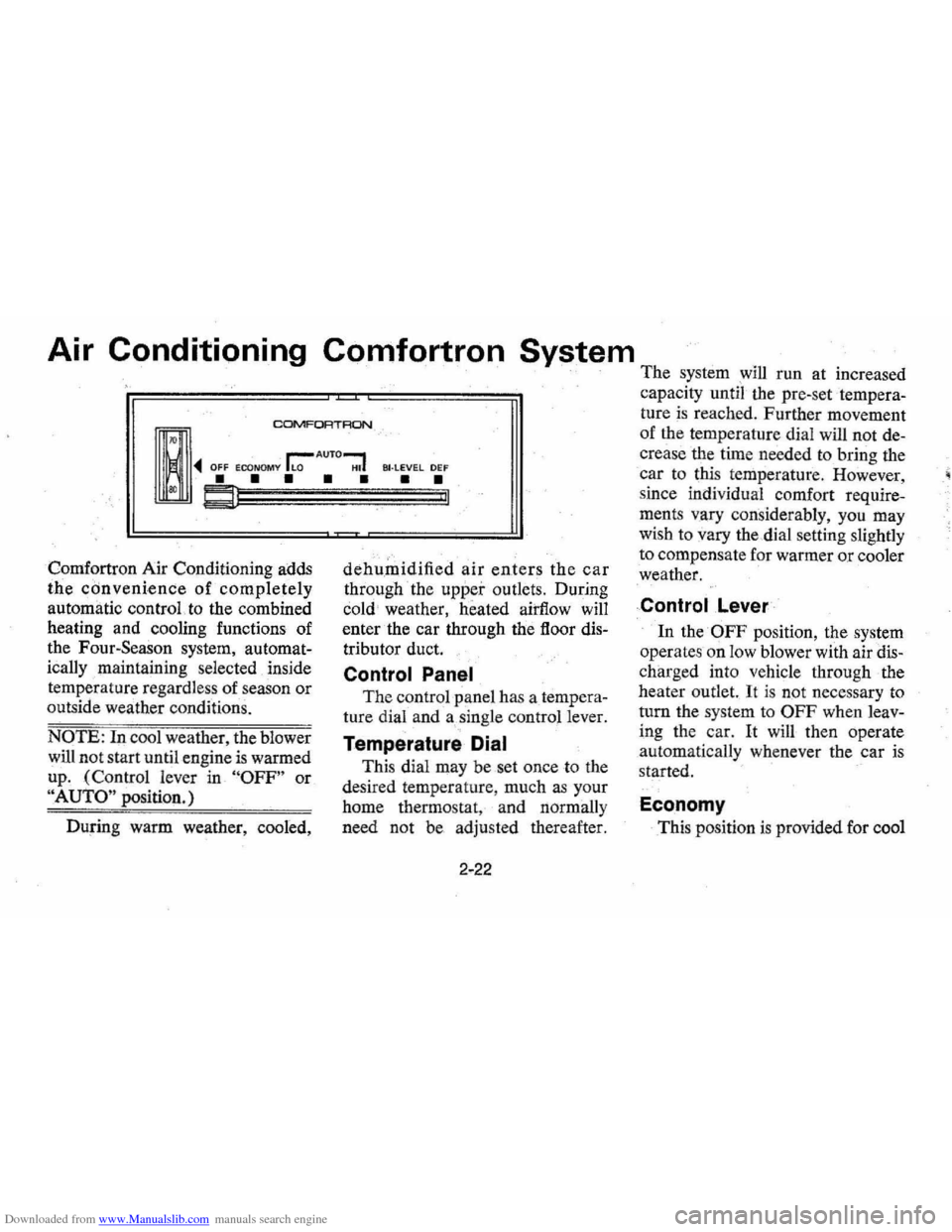
Downloaded from www.Manualslib.com manuals search engine Air Conditioning Comfortron System
The system will run at increased
. capacity
until the pre-set tempera
~
~ ~ OFF .00_:;;::;
• • • • • so i Ii
(U·LIEVEL OIEF
• • "I
Comfortron Air Conditioning adds
the convenience of completely
automatic control. to the combined
heating and cooling functions of
the Four-Season system,
automat
ically maintaining selected inside
temperature regardless of season or
outside weather conditions.
NOTE: In cool weather, the blower
will not start until engine is warmed
up . (Control lever in
"OFF" or
"AUTO" position.)
During warm weather, cooled,
dehumidified air enters the car
through the upper outlets. During
cold weather, heated airflow will
enter the car through the floor
dis
tributor duct.
Control Panel
The control panel has a tempera
ture dial and a single control lever.
Temperature Dial
This dial may be set once to the
desired temperature , much
as your
home thermostat, and normally
need not be adjusted thereafter.
2-22
ture is reached. Further movement
of the temperature dial will not
de
crease the time needed to bring the
car to this temperature . However,
since individual comfort
require
ments vary considerably, you may
wish to vary the dial setting slightly
to compensate for warmer
or cooler
weather.
Control .Lever
In the OFF position, the system
operates on low blower with air
dis
charged into vehicle through the
heater outlet.
It is not necessary to
turn the system to
OFF when leav
ing the car. It will then operate
automatically whenever the car is
started.
Economy
This position is provided for cool
Page 37 of 102
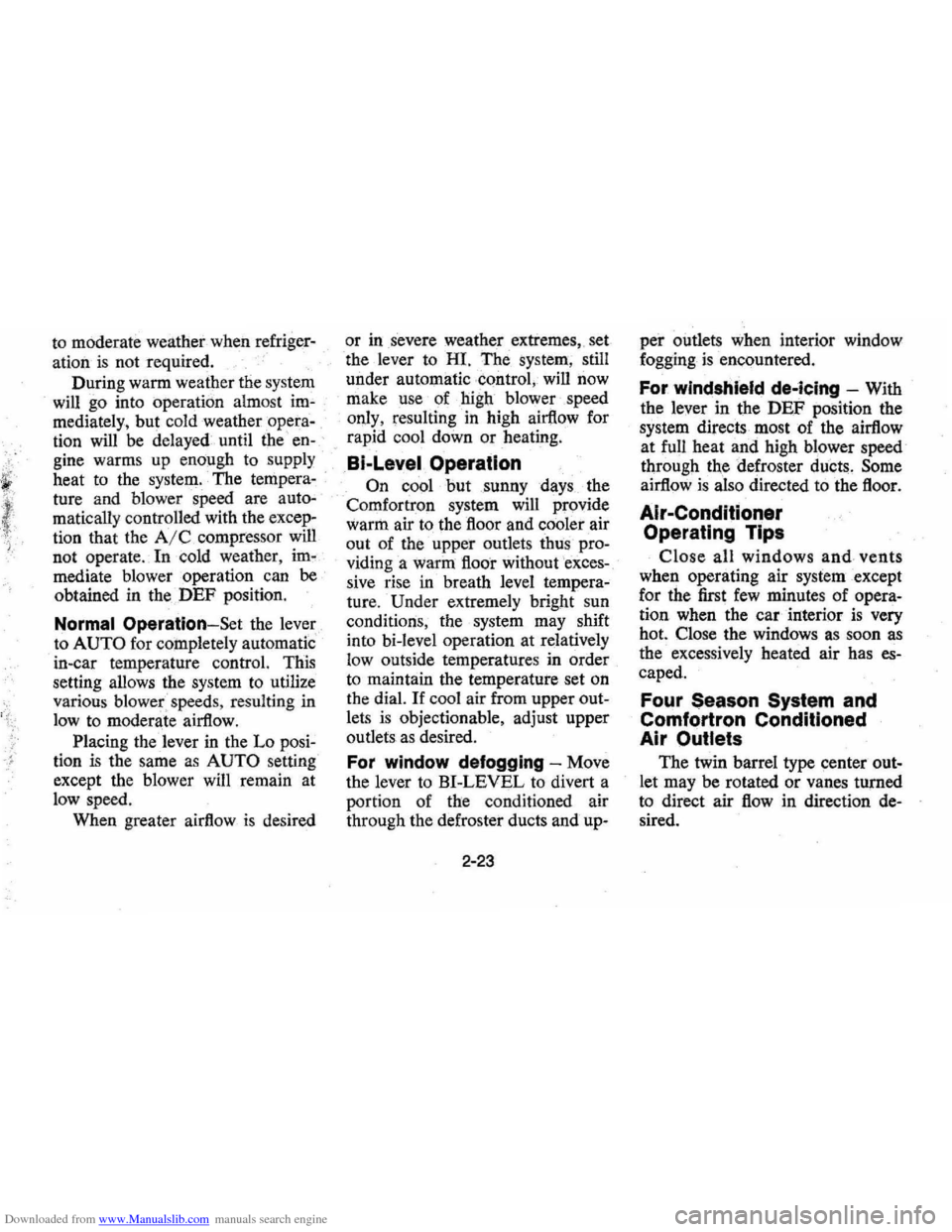
Downloaded from www.Manualslib.com manuals search engine (
-t·,
t "7,' ' , ' .
to moderate weather when refriger
ation is not required.
During warm weather the system
will
go into operation almost im
mediately, but cold weather opera
tion will be delayed until the en
gine warms up enough to supply
heat
to the system. The tempera- .
ture and blower speed are auto
matically controlled with the
excep
tion that the AIC compressor will
not operate. In cold weather,
im
mediate blower operation can be
obtained in the
DEF position.
Normal Operation-Set the lever
to
AUTO for completely automatic
in-car temperature control. This
setting allows the system
to utilize
various blower: speeds , resulting in
low to moderate airflow.
Placing the lever in the Lo posi
tion is the same as AUTO setting
except the blower wi\l remain at
low speed.
When greater airflow
is desired or
in severe weather extremes, . set
the lever to HI. The system , still
under automatic
·control, will now
make use of high blower speed
only, resulting in high airflow for
rapid cool
dOwn or heating .
BI-Level Operation
On cool but sunny days . the
Comfortron system
will provide
warm air to the floor and cooler air
out of the upper outlets thus
pro
viding a warm floot without 'exces
sive rise in breath level tempera
ture. Under extremely bright sun
conditions, the system may shift
into bi-level operation at relatively
low outside temperatures in order
to maintain the temperature set on
the dial.
If cool air from upper out
lets is objectionable, adjust upper
outlets
as desired.
For window defogging -Move
the lever
to BI-LEVEL to divert a
portion of the conditioned air
through the defroster ducts and up-
2-23
per outlets when interior window
fogging
is encountered.
For windshield de-icing -With
the lever in the
DEF position the
system directs most of the airflow
at full heat and high blower speed
through the defroster ducts.
Some
airflow is also directed to the floor.
Air-Conditioner
Operating Tips
Close all windows and vents
when operating air system except
for the
first few minutes of opera
tion when the car interior is very
hot. Close the windows
as soon as
the excessively heated air has es
caped.
Four season System and
Comfort ron Conditioned
Air
Outlets
The twin barrel type center out·
let may be rotated or vanes turned
to direct air
flow in direction de
sired .
Page 42 of 102

Downloaded from www.Manualslib.com manuals search engine level the car under various loaded
conditions. Air
is added to the
rear shock absorbers,
as needed,
through an air valve located
in the
rear bumper
as shown in the illus
tration. A minimum pressure of
10-\5 psi should be maintained at
all times. After the car is loaded ,
pressure may be increased until the
rear of the vehicle returns to the
normal designed riding height, but
not to exceed
90 psi.
Station Wagon
,t tor some reason, It Is necessary to drive with the tailgat. window open, the
Reclining Seat Back
Caprice
Models .
The passenger seat back can be
reclined rearward approximately
20 degrees from normal position
by lifting the control lever at the
outboard side
of the passenger's
following 'precautions should be observed:
• Close all other windows.
• Adjust heating or cooling system to torce outside air. Into, car 8S follows:
1. On $fatlon Wagons not equipped with' ai' conditlon;ng, set Ian to medium Ot high speed and upper control lever to any position except OFf. 2. On Station Wagons equipped with manua' air conditioning, set 'an to
2-28
seat cushion and. exerting rearward
pressure
or with no pressure on the
seat back
allow seat back to
return forward.
medium or, high sPded, upper control lever to any posWan except OFF, and lower control lever to any position
except extrem~ lett COLD.
3 . On Station Wagons equipped with a.utomaUc .'r conditioning. set ~ontrol lerer to HI except in hot weather, in which cas., set 'ever to AUTO.
• On starlon wagons equipped with ouiside air rents under or In Instrument panel, open venrs fully.
•
Page 65 of 102
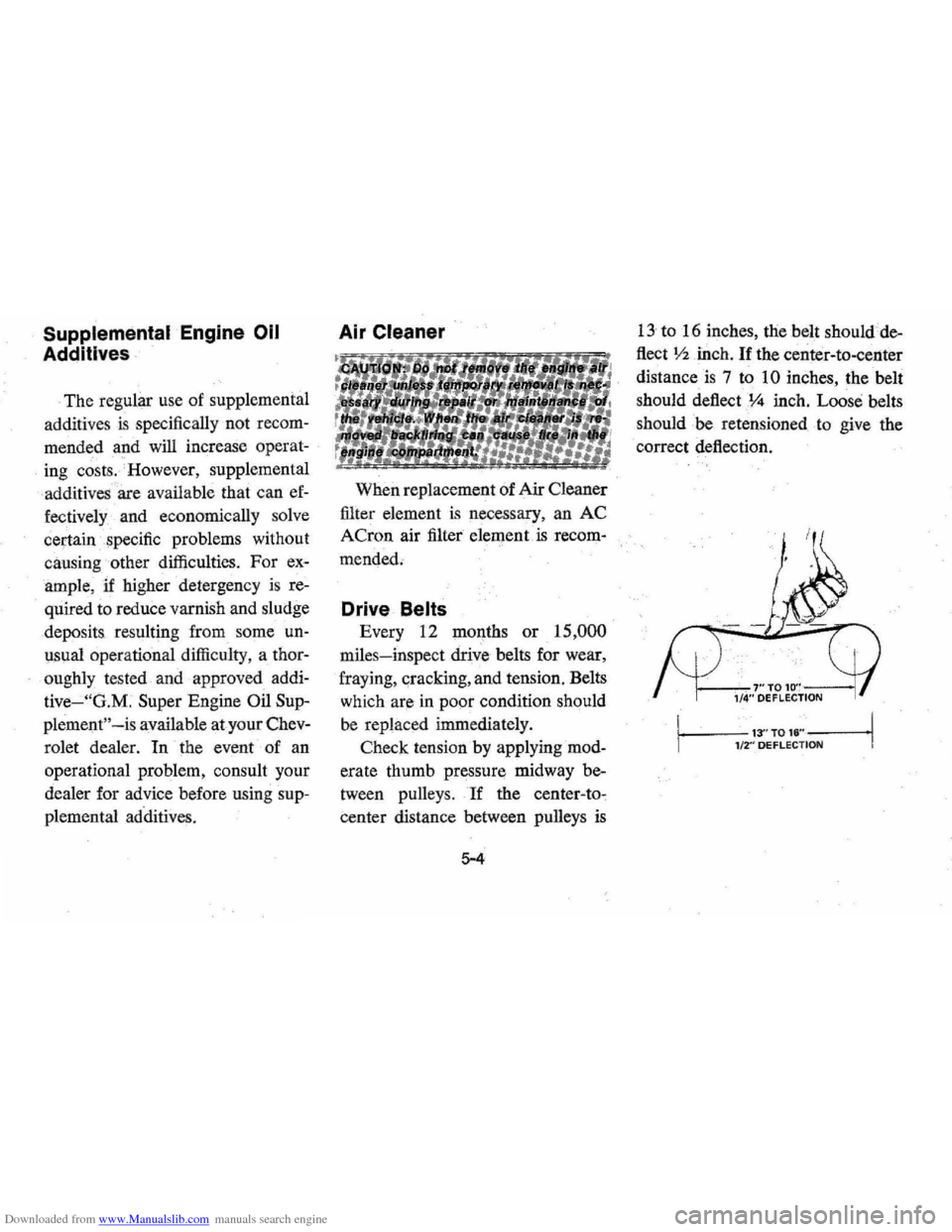
Downloaded from www.Manualslib.com manuals search engine Supplemental Engine 011
Additives·
The regular use of sUpplemental
additives is specific ally not recom
mended
and will increase operat
ing costs . However , supplemental
additives are avail able that can ef
fectively and economicall y solve
certain specific problems without
c ausing other difficulties . F
or ex
ample , if higher detergen cy i s re
quired to reduce varnish and sludge
deposit
s. resulting from some un
usual operational difficulty, a thor
oughly te sted and approved addi
tive-"G.M. Super Engine Oil Sup
plement "
-is availabl e at your Chev
r olet dealer.
In the event of an
operation al problem, consult your
dealer for advice before using sup
plemental additives.
Air Cleaner
When replacement of Air Cleaner
filter element
is ne cessary , an AC
ACron air filter element is recom
mended ,
Drive Belts
Every 12 mOJ.1ths or 15,000
mil es-inspect drive belts for wear ,
fraying,
qracking, and tension. Belts
which
are in poor condition should
be replaced immediately .
Check tension by applying mod
erate thumb pressure midway be
tween
pUlle y s. If the center-to ,
center distance between pulleys is
5-4
13 to 16 inches, the belt should de
flect Y
2inch. If the center -to-center
distance
is 7 to 10 inches, the belt
should
deflect .v.. inch. Loose belts
should be retensioned
.to give the
correct deflection.
>-~-7"TO'O"---1/4" DEFLECTION
I ... '3"TO"" I r-m"DEFLECTI~
Page 68 of 102
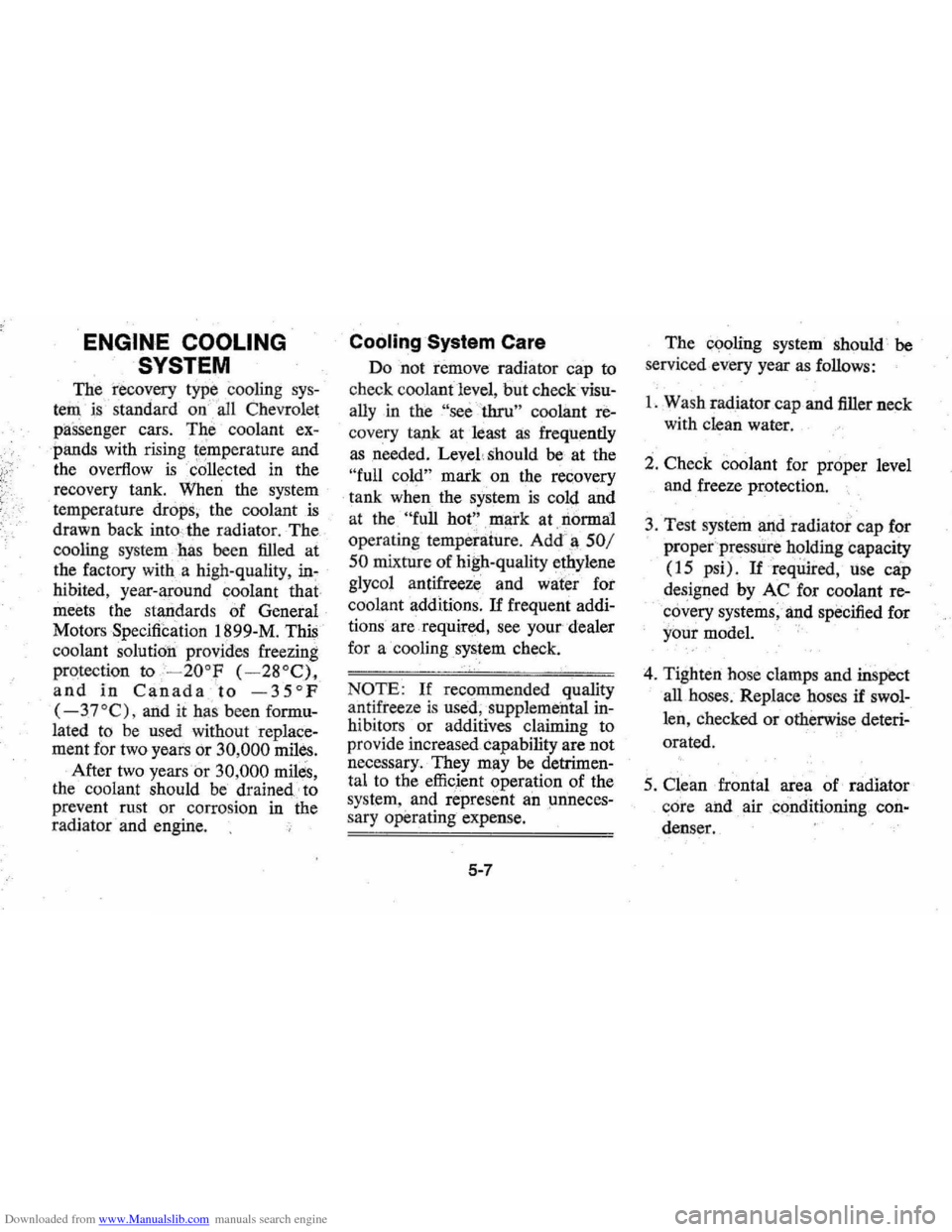
Downloaded from www.Manualslib.com manuals search engine ENGINE COOLING
SYSTEM
The recovery type cooling sys
tem is standard on all Chevrolet
pasSenger cars. The coolant ex~
pands with rising temperature and
the overflow
is dOllected in the
recovery tank.
When the system
temperature drops, the coolant is
drawn back
intocthe radiator. The
cooling system has been filled at
the factory with a high-quality, in
hibited , year-around coolant that
meets the standards
of General
Motors Specification I
899"M. This
coolant solution provides freezing
protection
to -20oP (-28°C),
and in Canada to _35°P
( -37°C), and it h~s been formu
lated to be used without replace
ment for two years or 30,000 miles.
After two years
or 30,000 miles,
the coolant should be drained to
prevent rust or corrosion in the
radiator and engine.
Cooling System Care
Do not remove radiator cap to
check coolantlevel , but
checkvisu
ally in the "see 'thru " coolant re
covery tank at least as frequently
as ,needed. LeveL should be at the
"full cold" mark on the recovery
tank when the system
is cold and
at the
"full hot" roark at Iiormal
operating temperature. Add'~ 501
50 mixture of high-quality ethylene
glycol antifreeze and
waler for
coolant additions.
If frequent addi
tionsare required, see your dealer
for
a cooling system check.
NOTE: If recommended quality
antifreeze
is used,supplemental in
hibitors or additives claiming to
provide increased capability are
not
necessary. They may be detrimen
tal to the efficient operation of the
system, and represent an
unneces
sary operating expense.
5-7
The cooling system should be
serviced every year as follows:
1. Wash radiator cap and filler neck
with clean water.
2. Check coolant for proper level
and freeze protection.
3. Test system
and radiator cap for
, properpresslire holding capacity
(15 psi).
Ifreqitired, use cap
designed by
AC for coolant re
co~ery systems, and specified for
your model.
4, Tighten hose clamps and
inspect
all hoses. Replace hoses if swol
len, checked or otherwise deteri
orated.
5. Clean frontal area of radiator
, qcire and air conditioning con
denser.
Page 73 of 102

Downloaded from www.Manualslib.com manuals search engine Accelerator Linkage
Lubricate with engine oil every
15,000 .miles as follows:
1. V-8 Engine-lubricate cable pin
at the carburetor lever.
Hinges
The following points should be
checked and lubricated every 6
months or
7,500 miles, whichever
occurs first: hinges on all doors,
fuel filler door, trunk lid, door lock
striker and door jamb switches.
Hood Latches
Every 6 months or 7,500 miles
whichever occurs first, lubricate
hood latch assembly and hood
hinge assembly
as follows:
1. Wipe off any accumulation of
dirt or contamination on latch
parts.
2. Apply Lubriplate
or equivalent
to latch pilot bolts and latch
locking
plate,
3. Apply light engine oil to all
pivot points in release
mecha
nism, as well as primary and
secondary latch mechanisms.
4. Lubricate hood hinges.
5. Make hood hinge and latch
mechanism functional check to
5-12
asSUre the assembly is working
correctly.
Air Conditioning
Have your Chevrolet Dealer
check your Air Conditioning
sys
tem at some time during the winter
months to be sure there has been
no loss in cooling output. During
the summer, see your Chevrolet
Dealer immediately if you suspect
the system
is nof performing as it
should.
NOTE: Your car's air condition
ing system will not operate be
low ambient temperatures of 300P
( -1°C) regardless of control
position.
Page 79 of 102

Downloaded from www.Manualslib.com manuals search engine Tire Repair
Temporary repair patches or any
repairs made from the outside of
the tire are not recommended ex
cept
in emergencies. Such "stop
gap" devices as plugs and aerosol
type sealants are not recommended
for more than
100 miles of driving
at speeds not over
50 mph. A per
manent
vulcanized repair (plug
and patch) applied from inside the
tire should be made
as soon as pos
sible. The installation of an inner
tube .
in a damaged tubeless tire
is not a recommended repair pro
cedure.
If an air loss occurs while
driving, do not attempt
to drive on
the deflated tire more than neces
sary to stop safely. Driving even a
short distance on a deflated tire can
damage a tire
-beyond repair.
The tire
in~ustry recommends
that punctures on passenger car type
radial tires up to
\4" diameter can
usually be repaired if they occur
5-18
between the major outer tread
grooves.
Traction and Snow Tires
A decrea se in driving, cornering,
and braking traction occurs when
water, snow , ice~ gravel, _ or other
material is on on the road surface.
Driving practices and vehicle speed
should be adjusted to the road
conditions.
When driving on wet or slushy
roads, it
is possible for a wedge of
water to build up between the tire
and road surface. This phenome
non, known
as hydroplaning, may
cause partial or complete loss of
traction, which adversely
affects
vehicle control and stopping
ability. To reduce the possibility of
traction loss, the
fan owing pre
cautions should be observed:
1. Slow down during rainstorms or
when roads are slushy.
2. Slow down if road has standing
water or puddles.